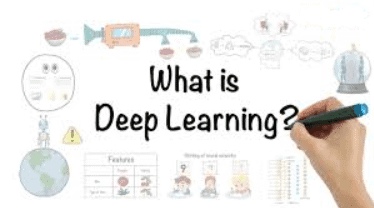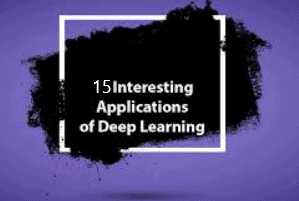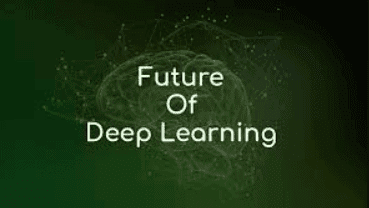What is Deep Learning
As an example, assume the input data is a matrix of pixels. the first layer typically abstracts the pixels and recognizes the edges of features in the image. The next layer might build simple features from the edges like leaves and branches. The subsequent layer could then recognize a tree and so on. The data passing from one layer to the next is considered a transformation, turning the output of 1 layer into the input for the next. Each layer corresponds with a unique level of abstraction and the machine can learn which features of the data to place in which layer/level on its own. Deep learning is differentiated from traditional “shallow learning” because it learns much deeper levels of hierarchical abstraction and representations.
How Deep Learning Works
Deep learning is getting lots of attention lately and for good reason, it's making a big impact in areas such as computer vision and natural language processing. Deep learning is often referred to as an end to end learning so let's take a look at an example say I have a set of images and I want to recognize which category of objects each image belongs to cars trucks or boats. I start with a label set of images or training data the labels correspond to the desired outputs of the task the deep learning algorithm needs these labels as they tell the algorithm about the specific features and objects in the image the deep learning algorithm then learns how to classify input images into the desired categories. We use the term end to end learning because the task is learned directly from data another example is a robot learning how to control the movement of its arm to pick up a specific object in this case the task being learned is how to pick up an object given an input image many of these techniques used in deep learning today have been around for decades for example deep learning has been used to recognize handwritten postal codes in the mail service since the 1990s the use of deep learning has surged over the last five years. Primarily due to three factors first deep learning methods are now more accurate than people at classifying images second GPUs enable us should now train deep networks and less time and finally large amounts of label data required for deep learning has become accessible over the last few years most deep learning methods use neural network architectures this is why you often hear deep learning models referred to as deep neural networks one popular type of deep neural network is known as a convolutional neural network or CNN a CNN is especially well-suited for working with image data the term deep usually refers to the number of hidden layers in the neural network while traditional neural networks only contain two or three hidden layers solve the recent deep networks have as many as 150 layers so now that you understand these key deep learning concepts here are a few examples that you can try with MATLAB recognizing or classifying objects into categories as seen here where a deep Network Classifieds objects on my desk detecting or locating objects of interest in an image like in this example where we use deep learning to detect a stop sign in an image I hope you found this overview helpful to find out more you can visit our website at matt burch comm slash deep learning you.
Evolution of Deep Learning
It’s the most valuable development in the world of AI in the present time. But rather than trying to understand the details of the field which could lengthen this article a little too much. Let’s just take a look at some of the main developments in the evolution of deep learning.
Although the study of the human brain is thousands of years old. the first step towards neural networks took place in 1943.
In 1943
When Warren McCulloch, a neurophysiologist, and a young mathematician, Walter Pitts, wrote a paper on how neurons might work. They modeled an easy neural network with electrical circuits.
In 1958
Frank Rosenblatt creates the perceptron, an algorithm for pattern recognition based on a two-layer computer neural network using simple addition and subtraction. The perceptron computes a weighted sum of the inputs, subtracts a threshold, and passes one of two possible values out as the result.
In 1980
Kunihiko Fukushima proposes the Neocognitron which is a hierarchical, multilayered artificial neural network. It's been used for handwriting recognition and other pattern recognition problems.
In the 1980s-1990s
John Hopfield presented a paper to the National Academy of Sciences. His approach to making useful devices.
Joint Conference on Cooperative/ Competitive Neural Networks at which Japan announced their Fifth-Generation effort resulted in the US worrying about being left behind. Soon funding was flowing once again.
Deep Learning was introduced to the machine learning community by Rina Dechter in 1986.
Yann LeCun’s invented the machine that could read handwritten digits. This invention felled beneath the wider world’s radar. While the algorithm worked and it required training for 3 days.
This time when the second AI winter kicked in, which also effected research for neural networks and Deep Learning. Various overly-optimistic individuals had exaggerated the “immediate” potential of AI, breaking expectations, and angering investors. Luckily, some people continued to figure on AI and DL, and some significant advances were made. In 1995, Dana Cortes and Vladimir Vapnik developed the support vector machine.
Sepp Hochreiter and Jürgen Schmidhuber publish a milestone paper on “Long Short-Term Memory” (LSTM). It’s a kind of RNN architecture that will persist to revolutionize deep learning in decades to come.
In 2006
Geoffrey Hinton, Ruslan Salakhutdinov, Osindero, and the altogether published the paper a fast learning algorithm for deep belief nets. in which they stacked multiple databases together in layers and called them Deep Belief Networks. The training process is much more efficient for a large amount of data.
In 2008
Andrew NG’s group at Stanford started advocating for the utilization of GPUs. So, that they can train Deep Neural Networks to hurry up the training time by many folds. this could bring practicality in the field of Deep Learning for training on a large volume of data efficiently.
In 2009
Finding enough labeled data has always been a challenge for the Deep Learning community. In 2009 Fei-Fei Li, an AI professor at Stanford launched ImageNet, assembled a free database of more than 14 million labeled images. it would serve as a benchmark for the deep learning researchers who would participate in ImageNet competitions (ILSVRC) each year.
In 2012
AlexNet, a GPU implemented the CNN model designed by Alex Krizhevsky. AlexNet won Imagenet’s image classification contest with an accuracy of 84%. It's a huge jump over 75% accuracy that earlier models had achieved. This win triggers a new deep learning boom globally.
In 2014
Ian Goodfellow created GAN also known as Generative Adversarial Neural Network. GANs open an entirely new door of application of deep learning in fashion, art, science, etc.
In 2016
Deepmind’s deep reinforcement learning model beats the human champion in the complex game of Go. the game is much more complex than chess. As a result, this feat captures the imagination of everyone. Also, it takes the promise of deep learning to an entirely new level. Self-learning computer eclipses human ability at complex game Go In 2019
Yoshua Bengio, Geoffrey Hinton, and Yann LeCun won Turing Award 2018. they had immensely contributed to advancements in the area of deep learning and AI. This was a defining moment for those who had worked relentlessly on neural networks.2018 Turing Award
By 2012, deep learning had already been used to help people turn left at Albuquerque (Google Street View). It inquired about the estimated average airspeed velocity of an unladen swallow (Apple’s Siri). In June of the year 2012, Google linked 16,000 computer processors, gave them Internet access, and watched as the machines taught themselves how to identify…cats. What may seem laughably simplistic, though, was quite earth-shattering as scientific progress goes.
Applications of Deep Learning
➽ Machine Translation
Thanks to deep learning, we've access to different translation services. one of the most popular ones, Google Translate helps its user to simply translate a language. No need for complicated steps, deep learning has helped this application improve tremendously. From just typing a word, to pronouncing a word, it sure is a big improvement from what's began to be.These improvements can be traced back to the use of a recurrent neural network that showed remarkable results in being able to translate languages. And as technology progress, deep learning algorithms partnered with the availability of data will help Machine Translation to continue to evolve.
➽ Virtual Assistants
The most popular application of deep learning is virtual assistants. From the likes Siri, Alexa, and Google Assistant, these digital assistants are heavily reliant on deep learning to understand its user and at the same time give the appropriate response in a natural manner.
Each interaction with the assistant provides them the opportunity to understand the voice and accent of its user and study the behavior of the user. Virtual assistants use deep learning to know more about their subjects ranging from your favorite places to your favorite songs.
Furthermore, virtual assistants are being incorporated into other devices ranging from cars and even microwaves. And because of smart devices and the internet, these assistants will continue to get smarter.
➽ Customer Service
Chatbots are everywhere and you've got surely encountered one. Deep learning has played a major role in helping businesses by improving customer service and making it more accessible to its customers.
Trained with a large amount of data, chatbots can understand customer requests and also guide the customer and help them resolve their problem in a human-like manner. Plus, it saves up customer's time and brings down the costs of business. Hoping that more businesses will take advantage of this to better customer service.
➽ Self-Driving Cars
We are definitely living in the future we all dreamed of. because of deep learning, self-driving cars do exist and are just going to keep on improving over time. Although it hasn’t been made available to the public yet, The Uber AI Labs at Pittsburgh isn't only working on making driverless cars but also integrating food delivery options with the utilization of this new invention.
Millions of data are being fed to the system to make a model, train the machine to learn, and then test the result in a secure environment. Data are coming from cameras, sensors and geo-mapping create sophisticated models that can navigate through traffic and identify paths and signs. Hopefully, these self-driving cars can be able to handle driving in an uncontrolled environment.
➽ News Aggregation
Everyone has encountered fake news one way or another. The Cambridge Analytica is a classic example of how fake news influence its readers’ perception. Deep learning helps develop classifiers that can detect fake or biased news and take away it from your feed.
On the other hand, news aggregation is the effort of customizing news depending on the readers’ persona.
➽ Digital Marketing
Everything is transitioning to digital now, even marketing. Traditional marketing isn’t that in-demand anymore and most businesses are taking advantage of the internet. the application of deep learning in digital marketing helps marketing professionals gauge the effectiveness of their campaigns.
It is revolutionizing the marketing industry by relying on data and its output. The accurate predictions of deep learning algorithms predict customer demand, customer satisfaction, and help them create a specific target market depending on their brand. it's truly becoming a useful asset for the modern marketing professional and keeping their services competitive.
➽ Natural Language Processing
One of the toughest tasks that humans can learn is knowing the complexities associated with language. Whether its semantics, syntax, tonal nuances, expressions, or even sarcasm, humans find it hard to simply grasp learning a language.
In deep learning, machines are trained to achieve the same thing and develop human-like response and personalized expressions. it's also trying to catch linguistic nuances and answer questions. it's also training machines to make phrases and sentences and capture local word semantics with word embedding.
➽ Colorizing Videos and Images
Who knows that machine can even have a creative side? because of deep learning frameworks, machines can flaunt their creativity by adding color to old black and white photos and videos. This application has captured the hearts of the older generation by giving more life to a memory they never thought to see in color again.
This won't sound as important as the other applications, but there are certain benefits to this. This application was able to color footage from the world war 1, although the footage isn't that significant, this could help uncover some new information.
➽ Entertainment
Have you ever felt that Spotify and Netflix recommend you exactly the things you like? Deep learning is the main reason for that. It plays a significant role in understanding its consumers’ behavior and generating recommendations to assist them to make choices for products and services.The more you interact with these applications, the more they gather information and suggest better options for you.
➽ Visual Recognition
Another application of deep learning is visual recognition. Pretty sure you've got encountered this through your social media application or on your smartphone. Basically, it sorts out images based on locations detected in photographs, a combination of people or looking on dates or events, etc.
When checking out a selected photo from Google’s picture library, it requires a state-of-the-art visual recognition system consisting of several layers starting from basic to advanced elements. Surely making everyone’s life easier especially the growing amount of photos taken.
➽ Healthcare
Deep learning has been playing a very important role in medical diagnosis and research. It helps with the diagnosis of life-threatening diseases, pathology results, and treatment cause standardization, and understanding genetics to predict future risks of diseases. Readmissions are a large problem in the healthcare industry and deep learning helps to combat this.
Although, some medical practitioners are still skeptical about the use of deep learning in the field of medicine.
➽ Personalization
Most businesses are now using chatbots to make customer experience personalized. As an example, eCommerce websites like Amazon, E-bay, Alibaba, etc are providing seamless personalized customer experiences by recommending products, packages, or discounts to its users. because of this, customers feel that their need is being fulfilled by these companies.
Some people tend to creep out by personal touch but nothing to worry as the data it collects are all from your previous interaction from the website or application.
➽ Fraud Detection
The banking and financial sector also benefit from deep learning applications especially money transactions are going digital. Furthermore, there are applications under development that will help detect fraudulent credit cards saving billions of dollars in recovery and insurance of financial institutions.
➽ Detecting Developmental Delay In Children
Autism, speech disorders, and developmental disorders can affect the standard of life to children who are affected by these problems. To deal with these situations, it's better for early diagnosis and treatment so that it can have a good effect on the physical emotional, and mental health of these differently-abled children.
Thanks to deep learning applications, speech disorders can now be easily detected even before kindergarten were most of the cases traditionally start. the same goes for autism and developmental disorders. it's surely a revolutionary thanks to using deep learning.
➽ Predicting Natural Disasters
In the long list of applications of deep learning, one among its most useful application is predicting an earthquake.
These computations are very intensive but they were able to improve the calculation time by 50,000%. Also, when it comes to earthquake calculation, timing is always important and plays an important role in saving one’s life. Once they perfected this machine learning, it'll save many people and maybe great equipment again natural disasters.
This domain has also opened a lot of opportunities and helped professionals in different sectors.
What is the Future of Deep Learning
So I think the the future of deep learning will progress on a number of different axes so I think we'll see continued progression of deep learning into all parts of commercialization in society in some way so impact many different types of businesses and different things that are maybe menial tasks and also improve you know quality and value kind of across across the board maybe similarly to how kind of software did in the 80s and 90s now deep learning is gonna kind of push this further and further forward it's also going to impact and change the way we think about intelligence and some of the more research side of deep learning and if you look at the progression of computing architecture with like the von Neumann architecture that was developed over many years through many efforts and many innovations that were small in in hindsight but really amassed into this and you know incredible thing we call the computer today and really deep learning is likely to be you know a piece of what we think of as intelligence in the future and many different components within deep learning will kind of subserve some tapestry of you know some future amazing technology that we might call just intelligent machines.Advantages of Deep Learning
The following are the benefits or advantages of Deep Learning:
➾ Features are automatically deduced and optimally tuned for the desired outcome. Features are not required to be extracted ahead of time. This avoids time-consuming machine learning techniques.
➾ Robustness to natural variations in the data is automatically learned.
➾ The same neural network-based approach can be applied to many different applications and data types.
➾ Massive parallel computations can be performed using GPUs and are scalable for large volumes of data. Moreover, it delivers better performance results when the amount of data are huge.
➾ The deep learning architecture is flexible to be adapted to new problems in the future.
Disadvantages of Deep Learning
The following are the drawbacks or disadvantages of Deep Learning:
➾ It requires a very large amount of data to perform better than other techniques.
➾ It is extremely expensive to train due to complex data models. Moreover, deep learning requires expensive GPUs and hundreds of machines. This increases the cost to the users.
➾ There is no standard theory to guide you in selecting the right deep learning tools as it requires knowledge of topology, training method, and other parameters. As a result, it is difficult to be adopted by less skilled people.
➾ It is not easy to comprehend output based on mere learning and requires classifiers to do so. Convolutional neural network-based algorithms perform such tasks.







7 Comments
Make a article on machine learning too.
ReplyDeleteAppriciated!🙂🙂
DeleteWe would like to make article on ML!
DeleteNice one man!
ReplyDeleteAppriciated!🙂🙂
DeleteNyc man just got what needed
ReplyDeleteAppriciated!🙂🙂
DeleteDon't Spam
Don't Use Harmful or Abusive Word